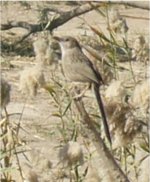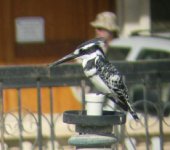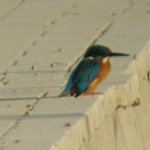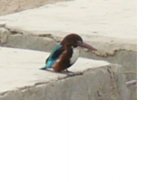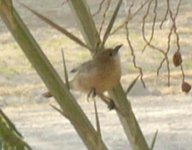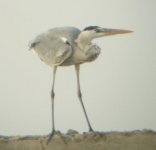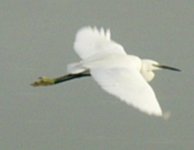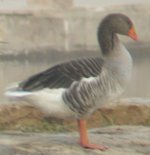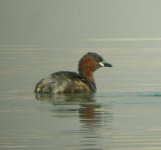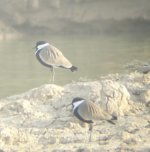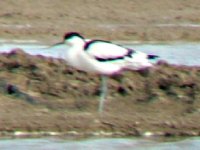Greetings!
Some interesting happenings occurred during this month. On 30 Dec 2005, 75 or so male Northern Shovelers appeared on our office lake along with a slightly greater number of females. By the 2nd or 3rd of January 2006 they were all gone. On the 5th of January a similar (and probably the same) sized flock returned to the lake. By the 8th they were gone again and didn’t return until the 26th. I’m not sure if this means they are at the southern limit of their migration and the flock is milling around the area, or if these are different flocks of about the same size passing through. I saw a pair of Mallards mating on the 25th, another sure sign of Spring. Gull numbers continue to increase. They are now numerous most of the day (more so in the mornings). On a small lake about a half mile from the office which is completely edged by reeds I saw over 400 gulls on the 5th. I’ve never seen more than one or two on this lake before and one can see three species regularly and the Yellow-legged Gull much less often. Great Cormorants also were seen in surprising numbers, mainly in large “V” formations fairly high overhead. A few were in fresh breeding plumage. On the 5th I saw a flock of about 110 flying North, followed by two smaller formations of about 30 each. By mid-month, heavy rains had flooded a dirt field of about 10 acres and in the newly formed shallow pond, I saw my first Black-winged Stilts, Pied Avocets and a Black-tailed Godwit mixed in with the numerous gulls there. A few days later I saw a White-tailed Plover, another lifer, picking along the newly formed “shore” line. I also made it to the big dump this month. There were easily thousands of gulls, and a good assortment of other birds. I saw my first jackdaw there and a couple of others that I couldn’t identify. January has proven to be very productive month in terms of numbers of species seen. If all goes well, February should be my last update to this string. The complete bird list for January month follows:
- Little Grebe, Tachbaptus ruficollis, about half a dozen now seen on the lake near my office.
- Great Cormorant, Phalacrocorax carbo, only three seen individually, otherwise, a few very large flocks (see above).
- Pygmy Cormorant, Phalacrocorax pygmaeus, a good numbers still seen during the month, one group of about 20 seen all drying their wings in shore-side reeds.
- Grey Heron, Ardea cinerea, fewer sightings but at least one adult and one juvenile still seen around the shallow ponds. Shortly after the big rains, five Grey Herons gathered on a flooded field, my single largest sighting of this bird while here.
- Night Heron, Nycticorax nycticorax, one seen during the evening along a canal for several nights (in the exact spot).
- Little Egret, Egretta garzetta, very few seen this month.
- Cattle Egret, Bubulcus ibis, one seen flying overhead near the Al Fah palace, one seen at the dump.
- Little Bittern, , a juvinal taking on adult plumage seen several days in the reeds along our lake’s edge.
- Greylag Goose, Anser anser, the same group was regularly seen.
- Common Pochard, Aythya ferina, only a couple dozen seem to be planning to stay for the winter.
– Mallard, Anas platyrhynchos, the numbers had increased but by month’s end only about five or six pair stayed on our office lake.
- Gadwall, Anas strepera, a few pairs stayed in the lake most of the month.
- Northern Shoveler, Anas clypeata, 75+ pair seen most of the month on our office lake.
- Eurasian Coot, Fulica atra. The most common bird on the office lake, approx 200 at times.
- Common Moorhen, Gallinula chloropus, a male and female seen along the reeds on the office lake, a few are seen regularly in the canals especially.
- Black-winged Stilt, Himantopus himantopus, five seen feeding in a recently flooded field at mid-month.
- Pied Avocet, Recurvirostra avosetta, a pair of adults seen in a recently flooded field at mid-month; another group of seven seen at month’s end.
- Spur-winged Plover, Venellus spinosus, rains have flooded most of their most common spots and far fewer were seen this month – stll a common sighting.
- Red-wattled Plover, Venellus indicus, only two seen early in the month along a drainage ditch; one seen with Spur-winged Plovers in a flooded pond during mid-month.
- Common Sandpiper, Actitis hypoleucos, few seen along lake shores and canals.
- White-tailed Plover, Vanellus leucurus, a single adult seen on a recently flooded field.
- Green Sandpiper, Tringa ochropus, one pair seen near Common Greenshanks and Spur-winged Plovers in the drainage ponds.
-Little Stint, Calidris minuta, a group about 20 dashing around our flooded field near a group of gulls and plovers.
- Common Greenshank, Tringa nebularia, two winter adults in a shallow slew near a drainage pond again.
- Black-tailed Godwit, Limosa limosa, one seen with Black-winged Stilts.
- Black Francoin, Francolinus francolinus, Two females seen along a drainage ditch in an abandoned field.
- Black-headed Gull, Larus ichthyaetus, large numbers of first year winter birds seen flying past the office.
- Slender-billed Gull, Larus genei, very small numbers seen when compared to Black-headed.
- Armenian Gull, Larus armenicus, one or two seen on the office lake; several on a flooded field.
- Yellow-legged Gull, Larus cachinnans, one seen with other gulls on a flooded field.
- Wood Pigeon, Columba palumbus, small numbers seen, mostly on open fields.
- Eurasian Collared-Dove, Streptopelia decaocto, large numbers seen daily.
- Feral Pigeon, large numbers seen everywhere.
- Pied Kingfisher, Ceryle rudis, a daily sighting in small numbers.
- White-throated Kingfisher, Haycyon smyrnensis, two sightings, and still the least common of the kingfishers seen here.
- Common Kingfisher, Alcedo atthis, one often seen near a the office and another regularly seen near a drainage canal near my trailer.
- Crested Lark, only one or two seen all month.
- Barn Swallow, two seen near the dining hall.
- Graceful Prinia, Prinia gracilis, small numbers seen in reeds along one of the ponds on Camp Victory and occasionally in dry scrub.
- Rook, Corvus frugilegus, fairly common and seen daily.
- Jackdaw, a few seen at the dump.
- Hooded Crow, Corvus cornix, seen daily but in less numbers than Rook.
- White Wagtail, Motacilla alba, small numbers seen along the canals and lake shores. A few large flocks seen in migration.
- Water Pipit, Anthus spinoletta, one seen feeding along a recently emptied water drainage ditch.
- White-cheeked Bulbul, Pycnonotus leucogenys, large numbers seen daily.
- Black Redstart, Phoenicurus ochruros, one or two adult male semirufus seen and two that did not have the “black bib,” probably immatures or the more common version seen further north and in Europe.
- Common Babbler, Turdoides caudatus, small numbers seen on Camp Victory.
- Iraqi Babbler, Turdoides alterostris, one only seen in the tall reeds along the office lake.
- Crested Lark, Galerida cristata, three or four sigtings, always of single birds.
- Chiffchaff, Phylloscopus collybita, a small group of four or five seen eating insects from trees near the office lake. These birds seem to have a regular feeding route that takes them through these trees every morning; they were rarely seen in the afternoon and never in the evenings.
- Spanish Sparrow, Passer hispaniolensis, a very few mixed in House Sparrows.
- House Sparrows continue to be one of the top two most common birds seen.





